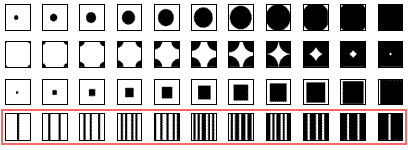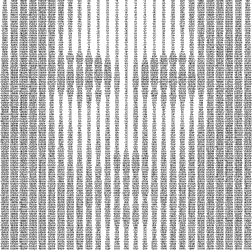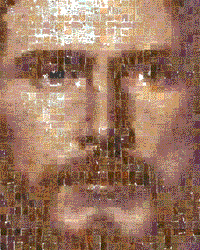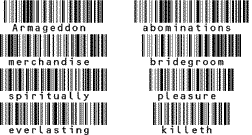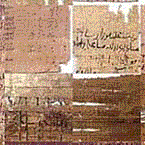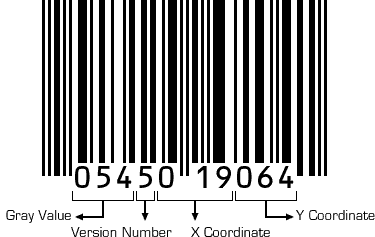Original Artist Statement
by Scott Blake My bar code art explores the process of making art with information and technology. As a computer artist I am in the business of selling 0's and 1's. The bar code represents automation, efficiency, and commodities. It is the universal icon for the computer revolution.
I started working on my first bar code portrait in 1998. Since then I have experimented with bar codes in many different forms, both on and off the computer. I have made videos, paintings, and gallery installations all based on bar codes. My bar code portraits have remained the main focus of this body of work. The people I choose to depict in my unique style of digital pointillism are very recognizable faces. I am interested in exposing what goes into the commercialization of individuals. My bar code portraits show what these people are made of.
Frequently Asked Questions
Q - How did you develop your bar code portraits?
A - In November 1998 I began experimenting with procedural ways of reproducing halftone printing techniques on my computer. I was trying to break down an image into small incremental units much in the same way that a digital printer breaks down an image into a manageable dot pattern. I created the first version of Bar Code Jesus using the bottom row of stripped pictures to render the entire image.
Q - I see more than eleven different bar codes in your final portraits. Where do you get all those different bar codes?
A - I wrote a Macros program inside Microsoft Excel that builds bar codes based upon a controllable density value. With that program I create a library of bar codes going from white to black. I use this giant archive of bar codes like a palate to paint whatever I want.
Q - How does the software arrange all of the bar codes into a larger picture?
A - Each bar code is nothing more than a pixel. The program works by replacing each pixel in the face image with a bar code. The computer already knows all the gray values for all the bar codes that it built earlier and so it just has to match them up with the similar values in the image.
Q - Is it all automatic?
A - Yes. I press one button and the computer does the rest. Writing the program that is behind that one button took me 6 months. The final resolution of my portraits is usually between 15,000 and 20,000 pixels square. So instead of working on the entire image all at once, I process the image in smaller sections. It takes my computer about 4 days to render one portrait.
Q - Do you use the same program for all your portraits?
A - No. Everytime I work on a new series I have to collect all the create all the digital bar code files
Q - What kind of computer do you use?
A - I work on a Macintosh G3 300MHz with 196 RAM.
Q - What kind of software do you use?
A - I use Adobe Photoshop and Microsoft Excel straight out of the box. I create my own smaller programs that run inside of those primary applications. I made all the bar codes using Macros in Excel, and I used Photoshop's Actions palate to convert all those pixels into bar codes. I also use Adobe Illustrator for all of my vector layouts, Adobe After Effects for all my motion graphics, and Adobe GoLive for designing this website.
Q - I see that you have done a portrait of Bill Gates. Was this a commissioned piece?
A - No. Bill Gates is the richest man in the world. I choose him because he's an icon.
Q - How much do you charge for a bar code image commission?
A - I do not do commissions.
Q - What is the difference between your work and Rob Silvers's Photomosaics?
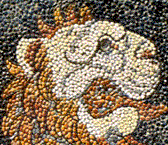 |
|
Greek pebble mosaic, detail from The Lion Hunt, from Pella, Macedonia, c. 300 BC. Dimitri (www.Britannica.com) |
A - We have both created a new gimmick using an old idea. The mosaic has been in art since the eighth century BC. Some of the early floor pattern designs where made using only white and black tiles, like bitmap mode. Other artist have experimented with this idea such as Chuck Close, Roy Liechtenstein, and Georges Seurat. Chuck Close has been a big influence on my art. His process of building a painting one block at a time encouraged me to work on my own designer pixels. Roy Liechtenstein's examination of Benday dots opened my eyes to the science of halftone printing. Photomosaics use tiles that are made out of photographs to create a mosaic image. My bar code portraits are made using bar code tiles. Each bar code in my portraits is nothing better than a fancy pixel. One tile in a Photomosaic represents "much more than a pixel." Below is a comparison of my Code 128/Jesus/Book of Revelation with a Photomosaic titled Christ II, which is composed from images of the Dead Sea Scrolls.
Q - What makes your portraits unique?
A - My bar code portraits are about making art with pixels. The pixel is a mosaic machine. Every pixel has several numbers assigned to it that describe its color and position. My bar code portraits make this data visible. The bar codes generated in my original bar code halftone have ten digits that relate to its gray value and grid coordinates.
The people I chose to render with my bar code program are popular faces. They each represent major trends in consumerism. These portraits examine what goes into making a face that sells. In my recent work I have reused some of these faces to further investigate the information that supports these giants.
May 2001 |

